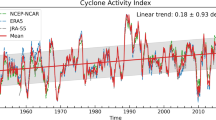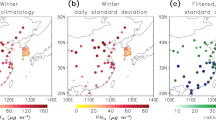Abstract
Direct human influences on climate have been detected at local scales, such as urban temperature increases and precipitation enhancement1,2,3, and at global scales4,5. A possible indication of an anthropogenic effect on regional climate is by identification of equivalent weekly cycles in climate and pollution variables. Weekly cycles have been observed in both global surface temperature6 and local pollution7 data sets. Here we describe statistical analyses that reveal weekly cycles in three independent regional-scale coastal Atlantic data sets: lower-troposphere pollution, precipitation and tropical cyclones. Three atmospheric monitoring stations record minimum concentrations of ozone and carbon monoxide early in the week, while highest concentrations are observed later in the week. This air-pollution cycle corresponds to observed weekly variability in regional rainfall and tropical cyclones. Specifically, satellite-based precipitation estimates indicate that near-coastal ocean areas receive significantly more precipitation at weekends than on weekdays. Near-coastal tropical cyclones have, on average, significantly weaker surface winds, higher surface pressure and higher frequency at weekends. Although our statistical findings limit the identification of cause–effect relationships, we advance the hypothesis that the thermal influence of pollution-derived aerosols on storms may drive these weekly climate cycles.
This is a preview of subscription content, access via your institution
Access options
Subscribe to this journal
Receive 51 print issues and online access
$199.00 per year
only $3.90 per issue
Buy this article
- Purchase on Springer Link
- Instant access to full article PDF
Prices may be subject to local taxes which are calculated during checkout


Similar content being viewed by others
References
Changnon, S. A. J METROMEX: A review and summary. Meteorol. Monogr. 40, 1–181 (1981).
Dettwiller, J. W. & Changnon, S. A. J Possible urban effects on maximum daily rainfall at Paris, St. Louis and Chicago. J. Appl. Meteorol. 15, 517–519 (1976).
Ackerman, B. S. et al. Summary of METROMEX Vol. 2, Causes of Precipitation Anomalies (Illinois State Water Survey, Urbana, IL, (1978)).
Houghton, J. T. et al. (eds) Climate Change 1995: The Science of Climate Change (Cambridge Univ. Press, (1996)).
Tett, S. F. B., Mitchell, J. F. B., Parker, D. E. & Allen, M. R. Human influence on the atmosphere vertical temperature structure: Detection and observations. Science 274, 1170–1173 ((1996)).
Gordon, A. H. Weekdays warmer than weekends? Nature 367, 325–326 (1994).
Graedel, T. E., Farrow, L. A. & Weber, T. A. Photochemistry of the ‘Sunday Effect’. Environ. Sci. Technol. 11, 690–694 (1977).
Parrish, D. D. et al. Export of North American ozone pollution ot the North Atlantic Ocean. Science 259, 1436–1439 (1993).
Pueschel, R. J., Boatman, J. F. & Artz, R. S. Aerosols over the western Atlantic: Scale heights, concentrations, and fluxes. Atmos. Environ. 22, 2371–2380 (1988).
Anderson, B. E. et al. The impact of U.S. continental outflow on ozone and aerosol distributions over the Western Atlantic. J. Geophys. Res. 98(D12), 23477–23489 (1993).
Dickerson, R. R., Doddridge, B. G. & Kelley, P. Large-scale pollution of the atmosphere over remote Atlantic Ocean: Evidence from Bermuda. J. Geophys. Res. 100, 8945–8952 (1995).
Cleveland, W. S., Graedel, T. E., Kleiner, B. & Warner, J. L. Sunday and workday variations in photochemical air pollutants in New Jersey and New York. Science 186, 1037–1038 (1974).
Altshuler, S. L., Arcado, T. D. & Lawson, D. R. Weekday vs. weekend ambient ozone concentration: Discussion and hypotheses with focus on Northern California. Journal of Air and Waste Management Association 45, 967–972 (1995).
Saeger, M. et al. The 1985 NAPAP Emissions Inventory (Version 2): Development of the Annual Data and Modelers' Tapes (US Environmental Protection Agency, Washington DC, (1989)).
Fishman, J. & Seiler, W. Correlative nature of ozone and carbon monoxide in the troposphere: Implications for the tropospheric ozone budget. J. Geophys. Res. 88, 3662 (1983).
Keeping, E. S. Introduction to Statistical Inference (Van Nostrand, Princeton, NJ, (1962)).
Siegel, S. Non-Parametric Statistics (McGraw-Hill, New York, (1956)).
Oltmans, S. J. & Levy, I. H. Seasonal cycle of surface ozone over the western North Atlantic. Nature 358, 392–394 (1992).
Ashworth, J. R. The influence of smoke and hot gases from factory chimneys on rainfall. Q. J. R. Meteorol. Soc. 55, 841–850 (1929).
Spencer, R. W. Global oceanic precipitation from the MSU during 1979–1991 and comparisons with other climatologies. J. Clim. 6, 1301–1326 (1993).
Livezey, R. E. & Chen, W. Y. Statistical field significance and its determination by Monte Carlo techniques. Mon. Weath. Rev. 111, 46–59 (1983).
Jarvinen, B. R., Neumann, C. J. & Davis, M. A. S. A Tropical Cyclone Data Tape for the North Atlantic Basin, 1886–1983: Contents, Limitations, and Uses (US Dept of Commerce, NOAA, Weather Service, Natl Hurricane Center, Coral Gables, Florida, (1984)).
Landsea, C. W. Aclimatology of intense (or major) Atlantic hurricanes. Mon. Weath. Rev. 121, 1703–1713 (1993).
Hays, J. D., Imbrie, J. & Shackleton, N. J. Variations in the earth's orbit: Pacemaker to the ice ages. Science 194, 1121–1132 (1976).
Gray, W. M., Frank, W. M., Corrin, M. L. & Stokes, C. A. Weather modification by carbon dust absorption of solar energy. J. Appl. Meteorol. 15, 355–386 (1976).
Gallo, K. P., Tarpley, J. D., McNab, A. L. & Karl, T. R. Assessment of urban heat islands: A satellite perspective. Atmos. Res. 37, 37–43 (1995).
Oke, T. R., Johnson, G. T., Steyn, D. G. & Watson, I. D. Simulation of surface urban heat islands under ‘ideal’ conditions at night, Part 2: diagnosis of causation. Bound. Lay. Meteorol. 36, 339–358 (1991).
Henry, J. A., Dicks, S. E., Wetterquist, O. F. & Roguski, S. J. Comparison of satellite, ground-based, and modeling techniques for analyzing the urban heat island. Photogr. Eng. Remote Sensing 55, 69–76 (1989).
Atkinson, B. W. The effect of an urban area on the precipitation from a moving thunderstorm. J. Appl. Meteorol. 10, 47–55 (1971).
Changnon, S. A. J Recent studies of urban effects on precipitation in the United States. Bull. Am. Meteorol. Soc. 50, 411–421 (1969).
Acknowledgements
We thank D. Parrish for the Canadian pollution data, S. J. Oltmans for the Bermuda ozone data, C. Landsea for the tropical cyclone database, and R. Spencer for the MSU daily precipitation data set.
Author information
Authors and Affiliations
Corresponding author
Rights and permissions
About this article
Cite this article
Cerveny, R., Balling, R. Weekly cycles of air pollutants, precipitation and tropical cyclones in the coastal NW Atlantic region. Nature 394, 561–563 (1998). https://doi.org/10.1038/29043
Received:
Accepted:
Issue Date:
DOI: https://doi.org/10.1038/29043
This article is cited by
-
Changing weekend effects of air pollutants in Beijing under 2020 COVID-19 lockdown controls
npj Urban Sustainability (2022)
-
Weekend effect in summertime temperature and precipitation over the Yangtze River Delta region
Theoretical and Applied Climatology (2022)
-
Weekday AOD smaller than weekend AOD in eastern China on the basis of the MODIS AOD product
Theoretical and Applied Climatology (2018)
-
Effect of personal exposure to black carbon on changes in allergic asthma gene methylation measured 5 days later in urban children: importance of allergic sensitization
Clinical Epigenetics (2017)
-
Public health risks of prolonged fine particle events associated with stagnation and air quality index based on fine particle matter with a diameter <2.5 μm in the Kaoping region of Taiwan
International Journal of Biometeorology (2016)
Comments
By submitting a comment you agree to abide by our Terms and Community Guidelines. If you find something abusive or that does not comply with our terms or guidelines please flag it as inappropriate.



